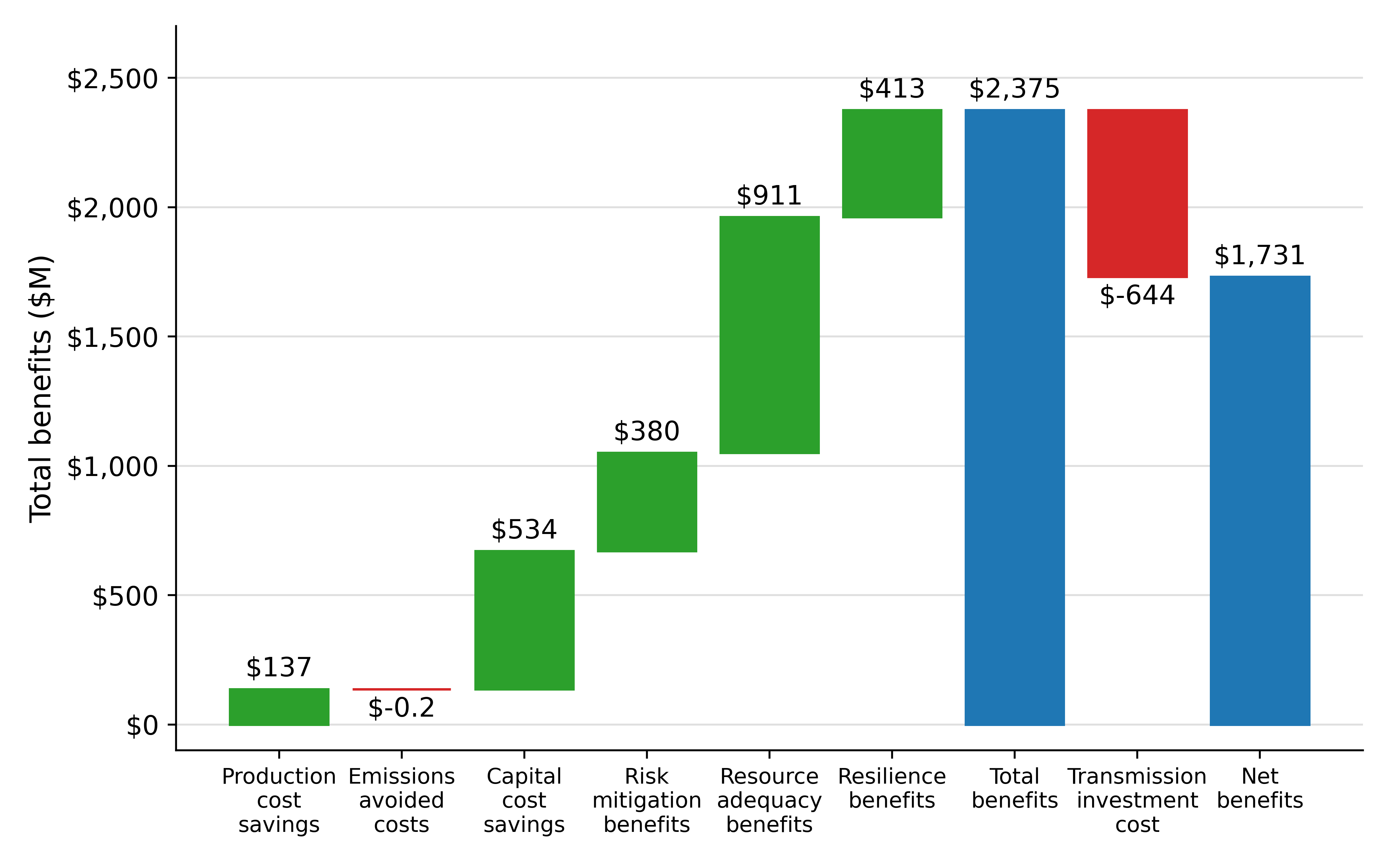Assessing the multi-value benefits of transmission expansion
Madeleine Seatle1*, Madeleine McPherson1, 1 SESIT group, University of Victoria, BC, Canada. * Correspondence: mseatle@uvic.ca
Key messages
- Transmission should be seen as much as an adaptation initiative as a mitigation initiative
- Interprovincial transmission provides significant reliability improvements to the system
- The value of transmission cannot be quantified purely through export revenues
Importance: The value of interprovincial transmission expansion has been underrepresented in historical cost-benefit analyses
The current Canadian transmission system is much more focused on international transmission as opposed to interprovincial transmission (Shaffer, 2021; Van De Biezenbos, 2022). This results in the underutilization of transmission between “provincial pairs” of low-emitting, hydro dominated provinces located next to high-emitting provinces more reliant on traditional fuels (Pineau, 2013; Shaffer, 2021), especially in the context of meeting Canada’s ambitious decarbonization policies (carbon pricing, the phase out of coal generation, a net-zero target, and the Clean Electricity Regulation (CER)).

Traditionally, transmission expansion has been evaluated primarily by assessing only how much transmission reduces operational costs of the system (Burgholzer & Auer, 2016; Dolter et al., 2022; Huber et al., 2014; Knopf et al., 2015; Lamy et al., 2014). The multi-value benefit (MVB) framework, used in this analysis, provides a more holistic view into transmission benefits (ESIG, 2022). When transmission expansion is unconstrained, COPPER (a cost optimization capacity expansion model) chooses to build 2.4GW between BC-AB and 1.5GW between MB-SK. Evaluating this expansion by traditional metrics, the benefit-cost ratio is minimal (0.13 and 0.33, for the BC-AB and MB-SK systems respectively); however, when considering reliability improvements, the benefit-cost ratio skyrockets (3.69 and 4.08, for the BC-AB and MB-SK systems respectively) and more accurately reflects the value of transmission expansion (Figure 1).
Opportunities and barriers: Reliability of grids is becoming increasingly important
Expanding interprovincial transmission in western Canada shows the most benefits in the reliability categories (risk mitigation, resource adequacy, and resilience) compared to the traditional benefit categories (production cost, emissions avoided, capital cost). Maintaining, and improving, electricity system reliability is a key priority as long as electrification continues to be an impactful strategy for Canada to meet decarbonization targets (Environment and Climate Change Canada, 2022). Canada’s electricity system has already been identified to be at risk of being overwhelmed by increased heating demand due to climate change (IEA, 2022) and this risk will only grow under deep electrification.
The pathways for accessing the full benefits of expanded transmission are different for each system; the results indicate that transmission expansion should be well underway in the MB-SK system by 2025 for the least-cost transition pathway to come to fruition, while the BC-AB system could realize the full benefits without any significant changes in capacity until 2030. This discrepancy in urgency needed from provincial governments speaks to the value of considering a MVB assessment for transmission expansion so that these benefits can be fully considered within reasonable timeframes.
Next steps: Increasing interprovincial cooperation can realize the full value of transmission
While the benefits of interprovincial transmission can clearly be seen from a reliability standpoint, there is the consideration of lost revenue if excess electricity is transferred between provinces as opposed to being exported to the United States. The value of electricity exported from BC is currently $375/MWh, while the total benefit of expanding transmission between BC and AB is over 2.5 times greater ($1,016/MWh). Even more stark, the value of electricity exported from MB is $147/MWh but the value of free trade between MB and SK, when considering the total benefits, is over 10 times greater ($1,521/MWh). This potential value to the system is unrealized when considering the monetary value only from the perspective of a single province, which is the level of regulation in the Canadian power sector. The benefits seen to provincial pairs systems in western Canada makes a compelling case for interregional transmission, but the mismatched regulatory structures of power sectors in each province poses challenges; this is causing some to call for federal support to help bridge the gap (Shaffer, 2021; Van De Biezenbos, 2022).
References
Burgholzer, B., & Auer, H. (2016). Cost/benefit analysis of transmission grid expansion to enable further integration of renewable electricity generation in Austria. Renewable Energy, 97, 189–196. https://doi.org/10.1016/j.renene.2016.05.073
Canada Energy Regulator. (2024). Electricity Exports and Imports -Table 2A: Export Summary Report by Source, Authorization and Exchange Type. Canada Energy Regulator. https://apps.cer-rec.gc.ca/CommodityStatistics/Statistics.aspx?language=english
Dolter, B., Fellows, G. K., & Rivers, N. (2022). The cost effectiveness of new reservoir hydroelectricity: British Columbia’s Site C project. Energy Policy, 169, 113161. https://doi.org/10.1016/j.enpol.2022.113161
Environment and Climate Change Canada. (2022). A clean electricity standard in support of a net-zero electricity sector: Discussion paper. Government of Canada. https://www.canada.ca/en/environment-climate-change/services/canadian-environmental-protection-act-registry/achieving-net-zero-emissions-electricity-generation-discussion-paper.html#toc4
ESIG. (2022). Multi-Value Transmission Planning for a Clean Energy Future: A Report of the Transmission Benefits Valuation Task Force. Energy Systems Integration Group. https://www.esig.energy/ multi-value-transmission-planning-report
Huber, M., Dimkova, D., & Hamacher, T. (2014). Integration of wind and solar power in Europe: Assessment of flexibility requirements. Energy, 69, 236–246. https://doi.org/10.1016/j.energy.2014.02.109
IEA. (2022). Climate Resilience Policy Indicator. IEA. https://www.iea.org/reports/climate-resilience-policy-indicator
Knopf, B., Nahmmacher, P., & Schmid, E. (2015). The European renewable energy target for 2030—An impact assessment of the electricity sector. Energy Policy, 85, 50–60. https://doi.org/10.1016/j.enpol.2015.05.010
Lamy, J., Azevedo, I. L., & Jaramillo, P. (2014). The role of energy storage in accessing remote wind resources in the Midwest. Energy Policy, 68, 123–131. https://doi.org/10.1016/j.enpol.2014.01.008
Pineau, P.-O. (2013). Chapter 13 - Fragmented Markets: Canadian Electricity Sectors’ Underperformance. In F. P. Sioshansi (Ed.), Evolution of Global Electricity Markets (pp. 363–392). Academic Press. https://doi.org/10.1016/B978-0-12-397891-2.00013-4
Shaffer, B. (2021). Technical pathways to aligning Canadian electricity systems with net zero goals. Canadian Institute for Climate Choices.
Van De Biezenbos, K. (2022). Lost in Transmission: A Constitutional Approach to Achieving a Nationwide Net Zero Electricity System. Osgoode Hall Law Journal, 59(3), 629–666. https://doi.org/10.60082/2817-5069.3813
Assessing the multi-value benefits of transmission expansion PDF
